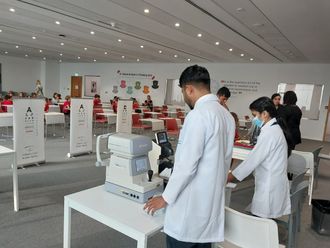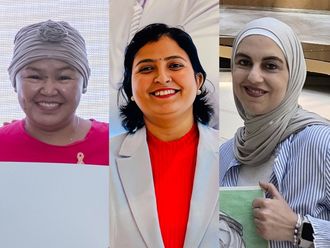Dubai Health Authority’s (DHA) Thalassaemia Centre announced that the mortality of thalassaemia patients was reduced to one patient in 2017.
The Director of the Thalassaemia Centre, Dr Khawla Belhoul, attributed the achievement to the joint efforts of the entire team, from the haematologists and nurses to the administrative staff.
Saving Lives
Dr Belhoul said that the mortality rate has been gradually declining over the years, reaching one patient in 2016. In 2013, eight from 438 patients (on regular blood transfusion) died from thalassaemia. In 2014, six of 447 patients died and in 2015 there were three mortalities from 436 patients. In 2016 and 2017, only one patient died each year from around 425 patients.
In the UAE, 8.5 per cent of the population are carriers. This is one of the highest rates in the world. However, Dr Belhoul said the rate can change from area to area in the UAE. In Dubai the average carrier rate is estimated to be 4.5 per cent according to 2015 statistics.
Dr Essam Dohair, senior haematology specialist and coordinator at the DHA’s Thalassaemia Centre, said the facility, established in 1989, was the first thalassaemia centre in the Middle East. Dr Dohair said that it currently has 850 patients with around 429 on regular blood transfusion.
“Thalassaemia is a recessive genetic disease, meaning both parents must carry the gene to pass it on to their children. In such cases, with each pregnancy there is a 25 per cent chance that a child will be born with the disease, a 50 per cent chance the child will only be a carrier and a 25 per cent chance the child will not be affected.
However, if only one person has thalassaemia it is still okay because the baby will be a carrier but won’t have thalassaemia.”
Dr Dohair stated that it is inadvisable for both partners with thalassaemia to get married because there is a strong possibility that their children will be carriers. The way to prevent this is for couples to agree to screenings prior to marriage.” Dohair said premarital screening has had a strong impact on reducing the incidence of the disease but the impact is not immediate. A premarital screening law for genetic diseases was introduced in 2006.
Addressing the causes
Hani Dowader, Haematology Specialist at the Thalassaemia Centre explained that the main cause of mortality in thalassaemia patients is caused by accumulating levels of iron in the body, especially in the heart. The accumulation is generated from hundreds of blood transfusions, together with increased absorption of iron from the diet. This causes critical organs and glands in patients with thalassaemia to experience serious iron-induced toxicity and early death.
Dr Ahmad Faraj, Haematology Specialist at the Thalassaemia Centre said a team was formed to find a solution to help solve this issue. “We resorted to a peripherally inserted central catheter (PICC Line) clinic, where patients could be given medication via a PICC Line insertion, assisted with CADD pumps — special implanted devices used in place of the usual needle — for a year. The method ensures that the iron is removed from the body,” he said.
Dr Faraj added that the PICC Line gives medication for 24 hours for a whole year (patients get it changed every week) so that it does not cause iron to harm the heart muscles.
“We taught them how to take care of it at home and the patient comes every week to change it. We found great results and thankfully, the mortality rate dropped to zero as a result. We won a number of awards for this treatment method.”
The nursing team also had a vital role in this achievement. They ensured that the patients took their required medications and they motivated them to attend their blood transfusion appointments. “We have created a family atmosphere where we encourage patients to comply with the medication and motivate them to come for blood transfusions on time. We also increased staffing by 50 per cent to meet the increased scope of work,” says Linet Saldanna, Head of Nursing.
Other members of the thalassaemia centre team who contributed to the centre’s success are Dr Fatheya Al Khaja, Head of the medical unit at the Thalassaemia Centre who is a member of the ‘Iron Fighters’ team, which aims to decrease the levels of iron in the blood by encouraging patients to take their blood transfusion treatments on time.
Dr Najim Al Deen Babaker, haematology and paediatric specialist, said his contribution to the success of the centre consists of diagnosing thalassaemia cases at a young age and educating the parents on how to take care of the children. He also creates plans to ensure that patients receive their required treatments. Al Deen said that his role is also to ensure that patients who are going to receive bone marrow are stabilised and ready for the surgery.
Samah Abdul Hameed, head of quality and developmental office at the centre contributed by reducing the mortality rate through the collection of data and conducting the necessary analysis to find the root cause of the disease’s mortality rate.
Since 2007, the centre has carried out community outreach and awareness activities, which directly resulted in reducing the number of thalassaemia cases in the emirate. The X-ray department at Rashid Hospital also played a big role, conducting iron tests to establish if iron was present in patients’ hearts. The Dubai Blood Donation also ensured that the centre was supplied the blood needed for transfusions.
Dr Belhoul said that, moving forward, the centre has three main goals. “Our main objectives are try to drop the mortality rate to zero, improve the quality of life of thalassaemia patients and focus on a cure through gene therapy.”












